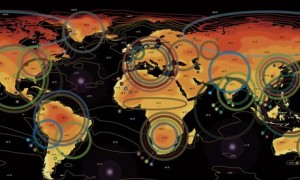
The impact of a global temperature rise of 4 degrees Celsius. Photo: Met Office (http://www.metoffice.gov.uk/climate-change/guide/impacts/high-end/map)
By Luisa Cristini, PhD, University of Hawaii at Manoa.
[Note from the editor: This is the fourteenth in a series of blog entries that will focus on introductory topics in climate dynamics and modeling, and will serve to provide insight into the current understanding of the science.]
Changes in external forcing (e.g., solar forcings, astronomical forcings, volcanic eruptions) have mostly driven past climate variations. To “predict” the climate of the 21st century and beyond, it is necessary to estimate future changes in the forcing. This can be accomplished through the development of scenarios for the emission of greenhouse gases, aerosols and other pollutants in the atmosphere, land, etc.
Scenarios depend on many uncertain factors. Some of the estimates of future climate changes are related to these unknown factors. For this reason, in the scientific literature, the term climate “projection” is preferred to the term climate “prediction.” Projection emphasizes the fact that the results depend on the scenarios chosen and the hypothesis made in those scenarios. The scenarios also are used to analyze impact, adaptation and vulnerability, and therefore provide a consistent approach for socio-economic and climatic issues.
In the fourth assessment report of the IPCC (2007), climate projections were based on the Special Report on Emission Scenarios (SRES) which covered the whole of the 21st century. These scenarios were derived in a sequential form. First, the main driving forces influencing the emissions from demographic, social and economic development were identified. This included estimated population growth, future economic activities, the market exchanges between different countries, the technology choices/opportunities of the various countries, etc. On the basis of these estimates, models produced scenarios for future emissions of greenhouse gases, aerosols and for land-use changes.
It is important to note that different combinations of demographic and socio-economic change can lead to similar emission paths. For example, large population growth combined with efficient technologies and renewable energy can lead to similar emissions to a smaller increase in the Earth’s population with less efficient and more energy-demanding technologies.
For the next IPCC assessment report, which will be released in 2014 (IPCC AR5), four so-called Representative Concentration Pathways (RCPs) have been adopted, representing four greenhouse gases (GHGs) concentration trajectories for the future. The emissions of GHGs corresponding to these four RCPs were provided to the climate-modeling community so that modelers could perform climate projections. In parallel, possible socio-economic scenarios compatible with those RCPs were developed, providing socio-economic alternatives for the same RCP.
The information provided by the climate-model projections also can be used in socio-economic scenarios to assess the impact of climate change on society. Such a parallel approach strengthens the collaboration between the different communities of climate modelers and socio-economic researchers, while ensuring that the climate-modeling groups only have to run a small set of (highly computer-time demanding) emission scenarios with their models. A further advantage of these new scenarios is that they include both detailed short-term estimates (to about 2035) and stylized estimates to about 2300, in addition to the classical, long-term estimates up to 2100 provided by the SRES scenarios.
It is important to notice that neither the SRES nor the RCPs make any attempt to provide a best guess or to assess the likelihood of the various scenarios. Many elements of the scenarios are too unpredictable for this to be feasible. As a consequence, all the scenarios should be considered as reasonable possibilities that are equally probable.
References and further resources
Goosse H., P.Y. Barriat, W. Lefebvre, M.F. Loutre and V. Zunz (2012). Introduction to climate dynamics and climate modeling. Online textbook available at http://www.climate.be/textbook/chapter6_node2.htm
IPCC (2000). Special Report on Emission Scenarios http://www.ipcc.ch/pdf/special-reports/spm/sres-en.pdf
IPCC Data Distribution Center (2011). Scenario process for AR5 http://sedac.ciesin.columbia.edu/ddc/ar5_scenario_process/RCPs.html

Comments are closed.